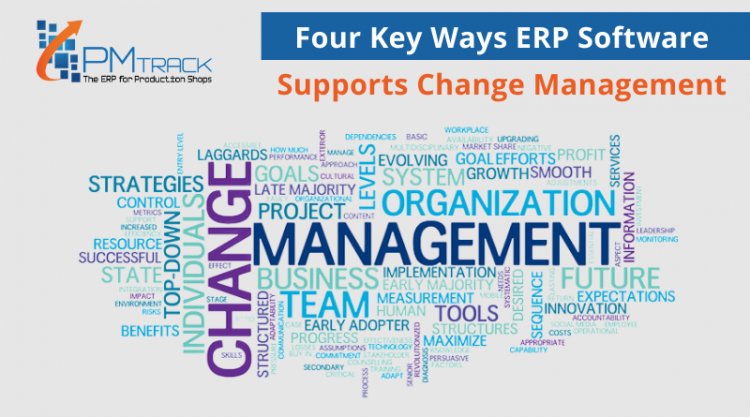Four Key Ways ERP Software Supports Change Management
Fear of transformation is simply a fear of navigating the adjustment. Successful change management makes the difference between a good plan and a fantastic transition. Management of transition – and change itself – is almost impossible without an ERP all-in-one infrastructure already in place. An organization that relies on a few dispersed legacy computing systems lacks agile internal contact networks. Knowledge will be lost, introducing new business procedures will be time-consuming, and improvements will be replicated into oblivion.

Fear of transformation is simply a fear of navigating the adjustment. Successful change management makes the difference between a good plan and a fantastic transition. Management of transition – and change itself – is almost impossible without an ERP all-in-one infrastructure already in place. An organization that relies on a few dispersed legacy computing systems lacks agile internal contact networks. Knowledge will be lost, introducing new business procedures will be time-consuming, and improvements will be replicated into oblivion.
Workplaces are constantly evolving as businesses go digital. Changes are being implemented at all levels, including processes, technologies, and people strategies. Legacy processes are being phased out in order to make the best use of available resources and infrastructure. Such initiatives, however, frequently result in extensive internal process changes that are not always easy to manage.
Change management encompasses all of the steps that businesses take to prepare for and support a business change. These include the various methodologies used to optimise resources, allocated budgets, and existing project operations. However, change management encompasses more than just projects and processes; it also includes employees and how their roles are affected. You must prepare, support, and equip your staff to implement the proposed changes, or they will face widespread opposition.
However, if you use an enterprise resource planning (ERP) system, your change management initiatives will go much more smoothly. Businesses that use ERP software have agile data sharing, which is required for change management. These types of businesses are better prepared to deal with data access and loss challenges during any internal change or transformation. In this article, we’ll look at four ways that ERP software can help with change management.
- Making Informed Changes
ERP applications that use dynamic reporting methods demonstrate the need for improvement. Access to business intelligence reports that cover all divisions’ operations will reveal opportunities for process optimization and obligation redistribution. If your company lacks centralised business management software, these opportunities for reform will emerge only when your profitability is jeopardised.
The ERP software changes your company implements will be strategic and supported by detailed business intelligence. Efforts to shift management led by knowledgeable managers would be more likely to succeed than those motivated by a desperate desire to protect the company.
- Access to Information
A business case for a change initiative is always supported by data. Businesses that prepare well by collecting, storing, and providing accurate data to all stakeholders are best positioned to successfully implement a change initiative.
How does ERP software help?
All ERP applications share a single database that supports multiple functions. Instead of having separate databases for each department, businesses now have access to a single data source, resulting in increased visibility and streamlined changes across departments. This also allows change agents—team leaders or managers in charge of process changes—to make more informed decisions.
ERP dashboards use color-coded bar charts and graphs to provide visual descriptions of key business/department metrics. To successfully track and measure change processes, it is critical that all employees have access to data metrics. Real-time data improves situational awareness, ensuring that your organization’s leadership and employees always have access to accurate, up-to-date information.
- Communication
Another important aspect of change management is communication. Clear communication of a change’s intent and implications is critical to the success of change management initiatives. It’s natural for employees to be confused about how future process changes will affect their current roles and responsibilities if they don’t fully understand them. Employees should also be able to communicate openly with change agents if they have any concerns.
How does ERP software help?
ERP software provides a centralized database that is not limited to a single executive or department. Everyone has access to this data, and all communication can be traced back to a single database. Every department can see the entire system in action and understand their exact position and role within it.
ERP software also ensures that messages are shared consistently across departments such as sales, customer service, production, operations, shipping, and accounting. This ensures that cross-departmental tasks are streamlined and that all business units communicate effectively during change initiatives.
- Data Protection
The greatest risk during any process change or internal transformation is data loss, and the majority of this data loss is due to human error. There is also the possibility of sensitive data being duplicated or mistranslated during internal transitions.
How does ERP software help?
Only authorized personnel can change or update data in ERP software. Access controls can be defined by businesses based on user roles. Only authorized users can create, update, and close change tasks assigned to different employees in change processes. In addition, the software keeps detailed audit logs to track what made what changes to the existing data. This ensures complete visibility and the security of business data at all times.
Conclusion
Implementing change management initiatives successfully requires collaboration, and with ERP software, you can streamline process changes with minimal impact on productivity.
To better manage change processes, as discussed in this article, take a few concrete steps, such as connecting all of your data sources to ERP software, involving your staff members to ensure consistent communication, and implementing access control for sensitive data. These steps will ensure that your company and its employees have a positive experience with change management.
PM TRACK ERP provides the best ERP solution for the manufacturing industry all over India, to schedule a free demo, get in touch with our team.












